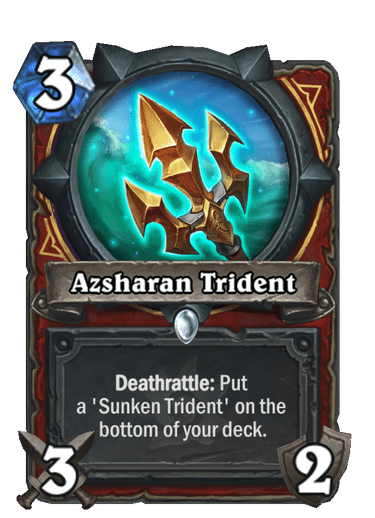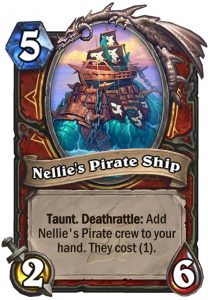
Forged in Flame

This card very easily draws 3 for 2 mana by just destroying an Outrider’s Axe with the last durability point. Alternatively, we could run Blacksmithing Hammer in the deck, trade it whenever it’s not convenient, and sack it to draw 5 cards whenever we can. Forged in Flame is the type of draw engine that makes Outrider’s Axe a bit more useful against decks that don’t give you swing targets for it. The only question is what happens when you don’t draw your weapon? It’s a dead card. It needs some weapon tutoring consistency, and the effect might be slow since you want to utilize weapon charges before activating it. Still seems like a card that will do stupid things at some point in the future.
Score: 3
Guard the City

This 2-drop is solid. A 2 mana 2/3 taunt that gains 3 armor is well above the curve and gives defensive Warrior decks some early game proactively. Can be worth 6 effective life. The best part about it is that it’s a spell, which means it evades all sorts of deck building restrictions, such as Vanndar and Kazakusan.
Score: 3
Azsharan Trident


Fiery War Axe is a very bad weapon, but Sunken Trident is very powerful. Dealing 2 damage to the opponent’s board twice over two turns is a devastating way to discourage any development from the opponent. The problem is that the process of getting it might be too slow. We have no tutor for weapons anymore with Corsair Cache leaving, so the process of drawing Trident, using the two charges, and then pulling Sunken Trident should be irrelevant in many of the faster matchups in which Sunken Trident is supposed to be most effective against.
The one deck this could be a strong fit in might be Quest Warrior, due to the first phase and Obsidiansmith, but we’d never run more than one copy and Hatchet is probably still better.
Score: 2
Obsidiansmith

This 2-drop is very good in Quest Warrior. Without any stat penalty, we’re able to either curve out a buffed pirate that makes sure we can progress the quest and maintain pressure on the opponent, or we pull Sunken Trident later in the game and devastate any opposition from the other side of the board. For a linear deck with one clear game plan, increased consistency is a major boon.
Score: 3
From the Depths

This card is a little weird. 3 mana for a dredge effect is quite expensive, even if we’re supposed to get back the mana next turn. This seems like a card that requires warped deckbuilding. For example, Galvangar Warrior could discount combo pieces with it, but it doesn’t need to. A Big Warrior deck may want this, but the dredge is not certain to hit a large threat and the archetype just lost many of its supporting cards. Kazakusan Warrior would never touch this. The idea of discounting treasures is funny but what does this card do until that point? It doesn’t fit an aggressive deck either and we would rather dredge Trident with Obsidiansmith.
Seems clunky on the surface, but we’ll respect the mana reduction potential.
Score: 2
Blackscale Brute

A 5/6 taunt and a 5/6 rush are a lot of stats for 7 mana. The weapon requirement isn’t too hard to achieve but we’re struggling to see where this card goes. It’s too slow and expensive for an aggressive deck and it’s awkward in Control Warrior because of deckbuilding restrictions. Perhaps we run it in a Vanndar build or perhaps it’s just a good standalone card that struggles to see play due to lack of fit.
Score: 2
The Fires of Zin-Azshari

This card seems incredibly fun but also incredibly bad. It can’t even be considered a reliable win condition. Playing one big, dumb idiot a turn isn’t really the way you win constructed games in Hearthstone. Once you transform your deck, you’re very unlikely to hit card draw effects. There’s a cute interaction with Vanndar here, but even when your entire deck costs 2, you still run into the problem of not being able to play multiple bodies and overwhelm your opponent. You must save card draw, find Vanndar, play Fires and go from there…
Or you could just play Kazakusan. It’s a tough sell.
Score: 1
Trenchstalker

This card is interesting. It impacts the board and can potentially hit an opponent in the face for 8 damage. The problem is that it costs so much mana. A 9-mana card needs to win the game once it’s played, and we’re not seeing a card here that’s significantly better than Troublemaker as a closing threat. We think it’s going to sit in our collection, menacingly, and not be used until a Big Warrior archetype can make its return.
Score: 1
Lady Ashvane

Can Lady Ashvane succeed where Hobart Grapplehammer failed? Clearly, Ashvane is a much better card with a stronger effect. The durability is the most important part for most weapons. She’s also stronger than Doctor Krastinov. The problem with this kind of legendary is that it only sees play if the deck’s entire strategy is warped by weapons. We had to play full throttle Bomb Warrior before Krastinov became meta, so Ashvane requires a similar one-dimensional shell. Eventually, it’s likely to happen and Ashvane will see play, she’s just going to be a little boring.
Score: 2
Nellie, the Great Thresher


This card might be a little misunderstood. It has a 42% chance to offer you Mr. Smite in the discovery phase. This means that Quest Warrior has an extremely high likelihood of having Mr. Smite either naturally drawn or generated by Nellie by the time it completes the quest. This is gross. There is no sacrifice made to run Nellie, as it is a threat on its own, offering a decent pile of stats for the cost and the opponent can’t really ignore it.
We can even see Nellie being ran in slower Warrior decks alongside Mr. Smite to offer a burst finisher by discovering pirates with the highest attack possible and charging them with Smite, but this is a major finishing upgrade for Quest Warrior, and it will become even more difficult to outlast the Juggernaut going forward. We’re not giving it the max score because it’s still a 7-mana non-pirate card, but this should be good.
Score: 3
Final Thoughts
Voyage to the Sunken City Set Rank: 8th
Overall Power Ranking: 1st
Warrior feels like a class that could have gotten nothing from the Sunken City set and still would have been competitive. It got more than nothing, so we think its future looks great, or scary depending on your perspective.
It begins with a format that’s dropping in power across the board. Inevitability is going to be way down. OTK’s are disappearing or losing a significant amount of power. This would lead to minions getting stronger, which means removal gets stronger. When removal is strong and can counter board development effectively, all it needs is a proper win condition and if it can get it with one card, you get the best-case scenario for it. We built Kazakusan Warrior, and it looks very, very good. It doesn’t look like a deck that went through rotation. It lost some card draw with Cache/Cutting Class, but it also got Execute, Bash and Shield Block. Those are major additions. We also think it has effective ways to compensate for some of the card draw it lost.
Then we have Quest Warrior. It got a significant boost of early game power thanks to some neutral additions as well as Obsidiansmith. It is going to be so much more consistent and faster to get the quest done. In fact, we think it will only run two cards that cost more than 3 mana. The Juggernaut’s going to come down on turn 7 every game, and Mr. Smite is going to be available more often too. This deck might be linear and one-dimensional, but the amount of raw power could still carry it to the top.
Warrior’s just good, and other win conditions are also available for it. Ironically, one of the only OTK’s left in the format is available to Warrior with Galvangar. It can fool around with the Fires of Zin-Azshari. It can go “big”. There are lots of ways it can potentially win Hearthstone games, but it will probably just do it with Kazakusan.
You wanted a board-based meta? You may want to brace yourself for the consequences. Heh, greetings.
